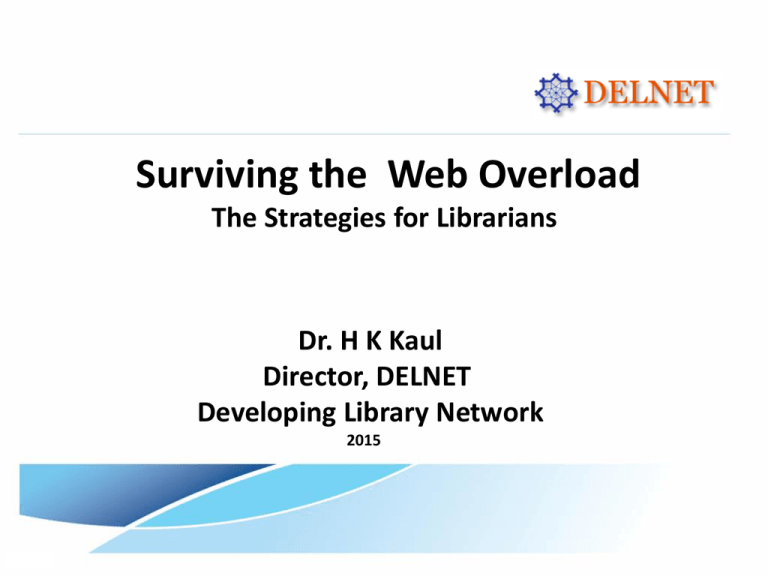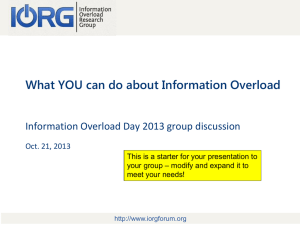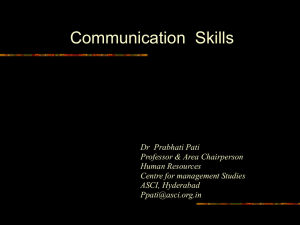Evaluating the Web Content(contd.)
advertisement

Surviving the Web Overload The Strategies for Librarians Dr. H K Kaul Director, DELNET Developing Library Network 2015 Information Growth • Twitter Jan 2009 2 million tweets June 2010 65 million tweets June 2011 200 million tweets May 2015 500 million tweets sent per day by 302 million monthly active users. • Information Growth Deluge in the information growth. Internet traffic has risen by 13,000% in last decade 2010, the quantity of information transmitted globally exceeded 1 zettabyte. Digital information is doubling every 2 years • Internet users - 1995 to 2015 (May) • • • • • Date 1995 2000 2014 2015 (May) Internet Users 44838900 413425190 2925249355 3123558790 Theoretical Model • • • • • • • • The theoretical model of information overload - The following parameters: Quantity of information Characteristics of information Quality of information Information processing capacity Available time Task and the process parameters Personal factors. • The Overload Agents • • • • • • • • A survey was conducted by Benselin and Ragsdell: among 45 persons: Frequency Number of Respondents 45 Email 40 The Internet - Search Engines 36 Friends and family 36 Colleagues 29 T. V. news channels 27 Facebook 25 Smartphone apps 23 The Overload Agents(contd.) • • • • • • • The Internet -News websites Newspapers (Online) The Internet - Corporate Websites Newspapers (hard copy) The Internet – Blogs The Internet – Forums Twitter 23 16 16 16 12 12 11 The Overload Agents(contd.) The Internet - Online shopping • Magazines • Other (Please specify) • RSS feeds • Other social media • None of the above • 11 8 7 5 3 0 Handling of the Information Overload Agents The simple principles to follow: General Issues: E-mails • Use umbra and penumbra principle all the time • • • • Prioritise E-mail tasks Genuineness of the Email Forwarding Sleep on It. Handling of the Information Overload Agents (Contd.) General Issues: Working in Office For LIS professionals working in office during the day. Chris Pirillo offers the following five basic tips: • Make Time to Unplug • Limit the Amount of Things You Can Focus On at One Time • Utilise Otherwise Wasted Time Differently • Plan Ahead • Try Not to Take On Too Much Collection Development (Print and Non-Print) • The collections have to be relevant to the research and reference needs of users. • The weeding out of publications/ collections • Regular exchange of ideas with specialists, students and teachers. Online Collections • Multiple sources including open access • Selection on the basis of the form such as manuscripts, books, articles, journals, newspapers, photographs, etc • On the basis of the subject such as Art, History, Physics, etc. • On the basis of collections such as Children’s Collection, • Heritage Collection, etc. • Combination of one or more characteristics. • Archived Collections • • • • • How to archive How to access archived collection How to update the archived collections Online storage for digitised collections Use of software like DSpace, Greenstone, EPrints, Fedora, Invenio, Opus et al. • Resource Sharing Information Search and Retrieval • Availability of discovery tools; ICT facilities • The education of users in search strategies • The use of Truncations; Wildcards searches, etc. • Subject headings - LOC 300 subject heading lists and thesauri • How to extract information from archives, business, historical and religious archives; mining of data from various specialised sources, etc. • Searching in social media (e.g. twitter and facebook) and other Web resources. • Interactive IR systems etc. • Library Websites Transparency in the functioning in a library makes the atmosphere more trustworthy and dependable. Besides proper guides, rules and reference counters, the library website can greatly reduce the overload. • University of Chicago Library • New York Public Library • Information Guides (How-to Guides) Research institutions have started introducing guides for the users, who benefit from this support. The following examples in this regard are for students in the field of Journalism at the University of Iowa. • Boolean Searching on the Internet • Lexis/Nexis Tutorial from John Hopkins University • Researching Companies Online. A tutorial • Information Guides (How-to Guides) • Web Search Strategies : A tutorial by Debbie Flanagan • Thinking Critically about World Wide Web Resources by Esther Grassian, UCLA College Library • Evaluating Quality on the Net by Hope N. Tillman, Director of Libraries, Babson College, Babson Park, Massachussets • How to Critically Analyze Information Sources - Cornell University Library Ranking by Citations Quality of content could be ranked by the number of citations it has attracted. Expert Citation Survey 2015 posted March 12, 2015 by Myles Anderson and filed under Citations, Research, gives the following results: • “71% say quality of citations is more important than quantity” • 55% say accurate citations are ‘critical’ to local search ranking (vs. 68% in 2013) • 45% say accurate citations are ‘very important’ to local search ranking (vs. 18% in 2013) Librarians need to maintain a directory of citations on the subjects of interest to them. The following citation management programmes are used at Cornell University Library: • Zotero; Mendeley; EndNote; RefWorks • Quality Filtering Information filtering includes the application of additional techniques that are incorporated in information retrieval. It is important to find: • In what context a particular subject is being discussed. This issue of contextualisation requires encyclopaedic knowledge, culture and judgment. Evaluating the Web Content: The strategies The University of Michigan Library has adopted the following guidelines: Evaluate the Intention of the Web site WHY was the Web site created? What purpose does the site serve? Information, entertainment, profit? What does the author get out of it? A laugh, a job, joy? What does the purpose tell you about the reliability of the information? What OPINION does this site represent? What point is emphasized by the web site? Is it reasonable? Is the tone reasonably objective or fanatical? What is conspicuously missing (if anything)? Do you see Logical errors or issues that have been avoided for no apparent reason? Evaluating the Web Content(contd.) Evaluate the Relevance of the Site How old is the web site or page? Can you tell when the page was posted to the web? Have the authors ever changed the content? Does it matter? Does timeliness matter to the subject of your paper or project? Evaluating the Web Content(contd.) • Evaluate the Reliability of the Site WHO created the site? • Can you tell? Does anyone claim authorship? • Who do the authors work for? What are their credentials? • Have you ever heard of them? Name recognition is important. • Current Awareness Service (CAS) Cornell University Library offers Current Awareness Service under the following heads: • New Books at Cornell; Table of Contents Alerts; Blogs; RSS Feeds; Facebook & Twitter • Social Bookmarking; Citation Alerts and Other Alerts The University of Sheffield Library offers a range of CA services through the Library Web and includes databases, such as ZETOC, electronic journals platforms of publishers and aggregators and include: • • • ZETOC via MIMAS JournalTOCS TechJournalContents • Federated Searches Federated searches take into account the quality of records searched mostly from the vetted sources. In a single unified search in real time important sources are grouped fast and presented to the searcher. Also, using filters the results can be further narrowed down. The Deep Web Technologies offers Alerts, Personal Library, Clusters and Facets, Search Widgets etc. • Packaging of Information • User Strategies User strategies could be divided into the following two sections: • The strategies users themselves adopt. • The strategies library professionals should adopt for them. The strategies users adopt according to Blummer and Kent: • They limit the acquisition of information • Out of the limited available resources they use the first few items only • They categorise information into chunks of information for further use. • User Strategies(contd.) • LIS professionals roles: Bawden and Robinson suggest LIS professionals to adopt: • Time management • Desk management • • • • Critical thinking Better information organisation Expanding access to scientific and e-journals Develop new skills and services among users including: • Developing new skills and services • Roaming reference service • Evaluating search results with users. • Information Literacy Changing nature and non-permanence of information can create issues of • Overload and addiction in the future. • More use of Web 2.0 technologies is essential. • People may be affected by lower levels of information literacy which results in overloaded. Increasing of information literacy is essential Role of Library Professionals The Subject Expertise Technical Knowledge Multidisciplinary Approaches Leadership Management Techniques Customer Targeting Encourage Group Discovery The Knowledge Centre Characteristics: • • • • • • • • • To Impart Appropriate Knowledge to Every User Collaboration with Knowledge Experts Use of Computer and Communication Technologies Local Knowledge Resources National Knowledge Resources International Knowledge Resources Culling Out Knowledge from Current and Old Resources Users’ Surveys Matching Resources with Users Needs How to Convert a Library into a Knowledge Centre • • • • • Bring Users and Experts Together Provide Access to National and Global Resources Develop Knowledge Repositories Manage Content in Full-text Form Arrange Cataloguing and Indexing of Resources using International Standards • Capture Knowledge • Give Links to Useful Sites • Make the Knowledge Centre as a ‘One-stop Centre’







